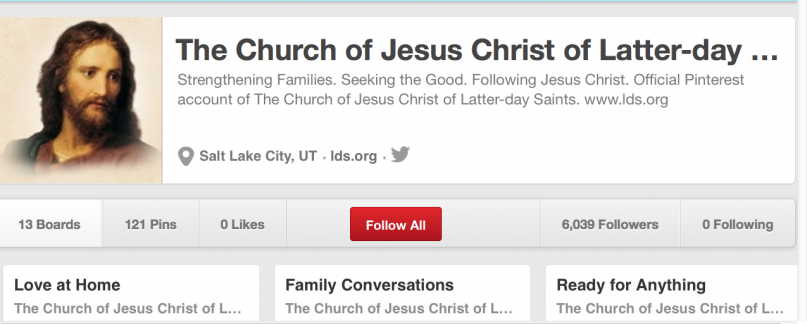 The LDS Church has announced that in addition to its ongoing presence on Twitter, Facebook, and YouTube (and Google+, but who actually uses that?), it’s now taken the leap into two other social media platforms: Pinterest and Instagram.
The LDS Church has announced that in addition to its ongoing presence on Twitter, Facebook, and YouTube (and Google+, but who actually uses that?), it’s now taken the leap into two other social media platforms: Pinterest and Instagram.
In case you’re waiting for me to say something sarcastic about this, you’re going to be disappointed, because I think it’s terrific for a couple of reasons.
First, the Church’s presence on Pinterest acknowledges the shift of information in our culture toward the visual, rather than the textual.
This came home to me in Primary on Sunday when our excellent teacher was trying to get the kids to tell her where they could hear the message of modern prophets. Online! they said. At the church’s website! they said.
No one, not one kid, mentioned a print magazine like The Ensign or even The Friend.
When faced with rapid, even tectonic, shifts like this, churches have two choices. They can either change or die. There’s no other way to put it.
I’m glad my church is not only coping with the new realities but leading the vanguard in embracing social media.
I compare this to some of the other churches I know and work with. I realize that in some ways this is not a fair comparison because those churches are so much less centralized around a denominational identity than Mormons are, and so much less able to coordinate any kind of joint effort on social media. Still, it’s striking to me how slow some other churches have been to adapt to social media as a method of communication.
Second, it’s encouraging to me that the LDS Church is utilizing Instagram in particular, since it appeals to a younger demographic. According to Business Insider magazine, over 90% of Instagram users are under age 35.
This is an age group that Mormonism risks losing, despite the Church’s great efforts in running singles wards and expanding its force of young missionaries. The national tide toward disaffiliation is so strong in this age group that it’s going to take some very creative efforts to keep them.
Social media can be one of those tools. One challenge for the hierarchical LDS Church is in realizing that it’s precisely the same centralized, hierarchical structure that enables it to present a strong and unified social media presence that also stands as a potential obstacle if it does not engage in the participatory give-and-take of social media.
Doing so in uncharted territory. It’s great for Mormon apostles to be on Twitter, which was the big news three weeks ago. But Elder Holland hasn’t posted anything since that first tweet on May 6, and Elder Ballard — the first leader to have an official Twitter account — has been silent since May 4.
Social media is only social if you use it — and engage with other people who are using it too. I hope the Church’s official accounts do more than broadcast their own message, though that is certainly important.
Social media is just not the same as broadcast media, in which a single authoritative voice presents a carefully prepared statement or program for mass consumption. Social media is a two-way street in which success depends on interaction.
Involving ordinary people not just as recipients of content but as co-creators is of course unpredictable and messy but also deeply fruitful, as it creates ties of investment and reciprocity.
I have high hopes for Mormonism’s official overtures into social media. I hope these official LDS accounts do more than just broadcast a message. I hope they retweet, repin, and share inspirational content from other people too — both members and non-members. I hope they engage the world outside the LDS bubble.





